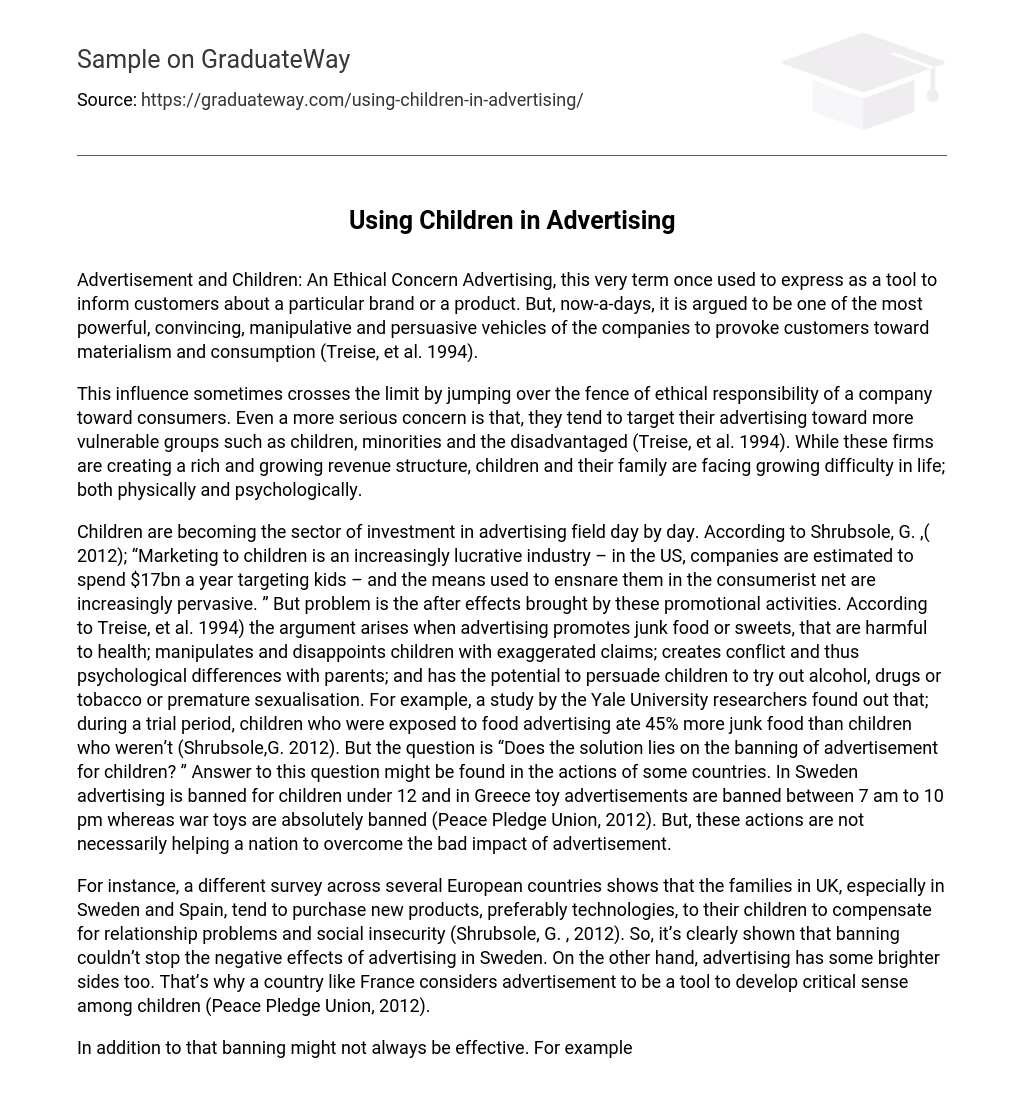Advertisement and Children: An Ethical Concern Advertising, this very term once used to express as a tool to inform customers about a particular brand or a product. But, now-a-days, it is argued to be one of the most powerful, convincing, manipulative and persuasive vehicles of the companies to provoke customers toward materialism and consumption (Treise, et al. 1994).
This influence sometimes crosses the limit by jumping over the fence of ethical responsibility of a company toward consumers. Even a more serious concern is that, they tend to target their advertising toward more vulnerable groups such as children, minorities and the disadvantaged (Treise, et al. 1994). While these firms are creating a rich and growing revenue structure, children and their family are facing growing difficulty in life; both physically and psychologically.
Children are becoming the sector of investment in advertising field day by day. According to Shrubsole, G. ,( 2012); “Marketing to children is an increasingly lucrative industry – in the US, companies are estimated to spend $17bn a year targeting kids – and the means used to ensnare them in the consumerist net are increasingly pervasive. ” But problem is the after effects brought by these promotional activities. According to Treise, et al. 1994) the argument arises when advertising promotes junk food or sweets, that are harmful to health; manipulates and disappoints children with exaggerated claims; creates conflict and thus psychological differences with parents; and has the potential to persuade children to try out alcohol, drugs or tobacco or premature sexualisation. For example, a study by the Yale University researchers found out that; during a trial period, children who were exposed to food advertising ate 45% more junk food than children who weren’t (Shrubsole,G. 2012). But the question is “Does the solution lies on the banning of advertisement for children? ” Answer to this question might be found in the actions of some countries. In Sweden advertising is banned for children under 12 and in Greece toy advertisements are banned between 7 am to 10 pm whereas war toys are absolutely banned (Peace Pledge Union, 2012). But, these actions are not necessarily helping a nation to overcome the bad impact of advertisement.
For instance, a different survey across several European countries shows that the families in UK, especially in Sweden and Spain, tend to purchase new products, preferably technologies, to their children to compensate for relationship problems and social insecurity (Shrubsole, G. , 2012). So, it’s clearly shown that banning couldn’t stop the negative effects of advertising in Sweden. On the other hand, advertising has some brighter sides too. That’s why a country like France considers advertisement to be a tool to develop critical sense among children (Peace Pledge Union, 2012).
In addition to that banning might not always be effective. For example, one important factor can be, a country can ban their internal advertisement, but can’t stop advertisements of international channels since they don’t follow their internal regulations. Moreover, some advertisement can be educative and persuade children to adapt a particular healthy lifestyle; like the Colgate Toothpaste advertisements motivate children to brush twice a day. So, in one word what might be the solution to the problem of the adverse effect of advertising over children; one thing is for sure, “Banning” is definitely not it.
References: Peace Pledge Union, 2012. Children and Advertising: the European Dimention, PPU Information. [online] Available at http://www. ppu. org. uk/chidren/advertising_toys_eu. html [Accessed 18 Ocober 2012] Shrubsole, G. 2012. Marketing and advertising that respects children’s rights, The Guardian [online]12 March. Available at http://www. guardian. co. uk/sustainable-business/marketing-advertising-respect-childrens-rights [Accessed 18 Ocober 2012] Treise, D. et al, 1994. Ethics in Advertising: Ideological Correlates of Consumer Perceptions. Journal of Advertising, XXIII(3), pp. 59-60.





